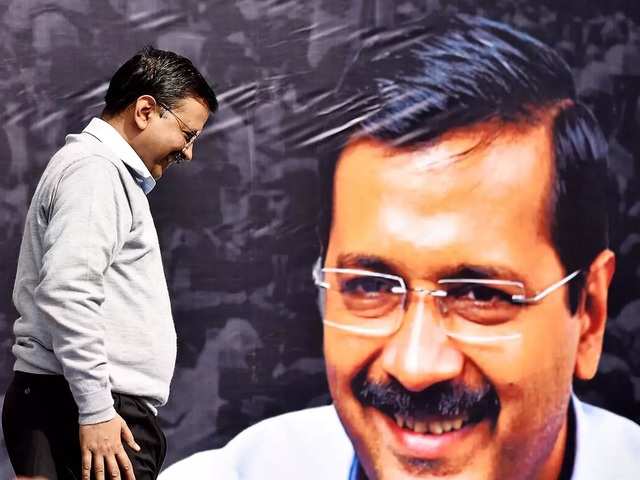View: Arvind Kejriwal's victory showed he has learnt lessons from past
Kejriwal’s tactics must be seen in the backdrop of inclusive nationalists being in retreat for several decades, particularly after the onset of the Modi era. Over the last 70-odd years, the scales have gradually tilted in favour of ‘cultural nationalists’, reflected in political leaders since Indira Gandhi embracing what is dubbed as ‘soft Hindutva’.
by Nilanjan Mukhopadhyay
Journalists, as opposed to ‘data scientists’, often use anecdotal evidence to write their reports. Compiling empirical data requires time and resources, not always available to all journalists chasing daily deadlines. Even though I’m not an app-based taxi driver eager to collect ‘alert citizen’ certificates, I do regularly eavesdrop.
A few days ago, I was privy to the conversation between a young voter and his mother inside an elevator. ‘They should become a national party,’ the son asserted. The mother nodded, ‘He is PM material.’ The most significant thing about this tête-à-tête was that the two were not even Delhi voters, since stepping out of the lift, the son said, ‘If he does become PM, at least Ghaziabad will not become Mahant Digvijay Nagar or Maharaja Agrasen Nagar.’
This conversation on counting day in Delhi echoed the seriousness with which the newly discovered ‘Delhi model’ of governance was being discussed by worthies. Also being debated was if Arvind Kejriwal’s formula was replicable in other states or not. For the second time in his short political career, the Delhi chief minister’s potential as a challenger, and political alternative, to BJP is being weighed.
Unlike this time, the first time around, the question popped up at Kejriwal’s behest — when he had decided to contest against the not-yet prime minister, Narendra Modi, in the 2014 Lok Sabha elections from Varanasi. Although trounced, he was not humiliated, and Aam Aadmi Party (AAP) picked up a handful of Lok Sabha seats. The astonishing victory in Delhi in 2015 raised visions of the party’s expansion to other states. But before it could go further, hopes were dashed, for two reasons.
First, Kejriwal did not turn out to be much different from those he was seeking to replace. His response to demands for debate within the party established that he was as much an oligarch as chiefs of almost every other political party showcasing its democratic credentials.
Arvindji vs LGji
Kejriwal’s second error was in locking horns with Modi at every step, confronting the Centre’s representative in Delhi, the lieutenant governor, on every occasion, and becoming overambitious about AAP’s political presence in states beyond Delhi. He paid the price and learnt the lesson — most importantly, the rules of the game, paradoxically, the rules he had set out to change.
AAP’s campaign for last weekend’s assembly polls emphasised three narratives. First, this was a ‘local’ election, and Kejriwal had no ambition of using this verdict as some kind of stepping stone for prime ministerial ambitions. Two, he emphasised belief in ‘kaam ki rajniti’ (politics of doing) — a quaint mix of freebies and welfarism.
Three, it was repeatedly underscored that he was ideologically agnostic. BJP repeatedly tried pinning him to a stance on what it attempted to make Issue No. 1: the Shaheen Bagh protests. But he astutely refused to take a categorical position. On the one hand, he stated that if his government had control over the police, it would have ‘cleared the area within two hours’. On the other hand, he maintained that the Citizenship (Amendment) Act (CAA) was a national concern, but not relevant during Delhi elections.
Coupled with support to the Centre on the decision to water down Article 370 and the decision to hail the Supreme Court’s verdict on Ayodhya, Kejriwal’s recital of the Hanuman Chalisa blunted BJP’s Hindutva blitzkrieg against AAP. The few Urdu shayari-loving BJP supporters would have recalled (if not publicly recited) Pakistani poet Fahmida Riaz’s poignant lines — Tum bilkul hum jaise nikle, ab tak kahan chhupe thhey bhai? (Your turned out to be just like us, where were you in hiding all this while?) — after listening to Kejriwal claiming that the Pavanputra god had blessed Delhiites with the poll verdict on Tuesday, considered to be Hanuman’s day.
Kejriwal’s tactics must be seen in the backdrop of inclusive nationalists being in retreat for several decades, particularly after the onset of the Modi era. Over the last 70-odd years, the scales have gradually tilted in favour of ‘cultural nationalists’, reflected in political leaders since Indira Gandhi embracing what is dubbed as ‘soft Hindutva’.
Now for High-Hanging Fruit
This sentiment has been around from the 1950s. Even Jawaharlal Nehru pledged government funding for the Kulu Dussehra festival to bolster the tradition. BJP’s singular success in recent years, initially by riding the Ram Janmabhoomi movement, has been in erasing the dividing line between cultural and political Hinduism. Many liberal Indians hope Kejriwal successfully redraws this line, and accepts the necessity of articulating minority-specific issues in the political space as well.
The moot question is whether in the longer run, Kejriwal is willing to take a risk, and stand in opposition to Hindutva, as a vocal upholder of an inclusive and diverse view of nationalism, as well as his credentials as an able administrator.